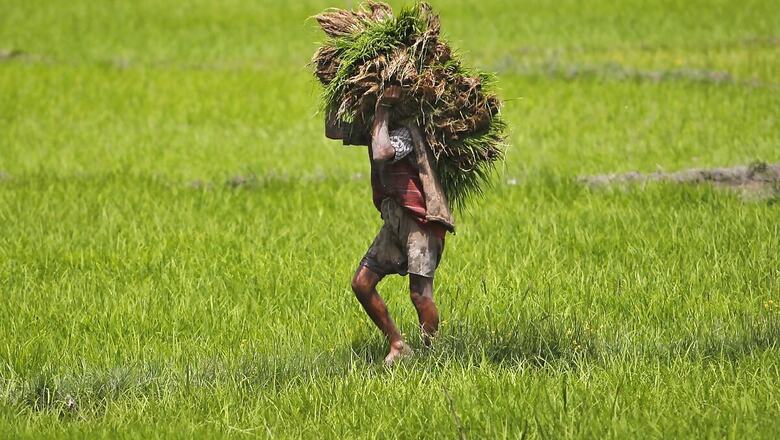
views
In its budget for 2021-22, the Punjab government has initiated a three-year-long project — “Kamyaab Kisan Khushaal Punjab” (K3P) — to improve the incomes of farmers and promote “sustainable agriculture” and “farmer prosperity”. The K3P project has been budgeted Rs. 3,780 crore over the next three years, with Rs.1,104 crore being made available for the current financial year (2021-22) to kick-start the programme.
The stated objective of K3P is to strengthen our agricultural sector across several dimensions — for providing livelihood, food and nutritional security to farmers, as well as making the state’s agriculture sustainable.
K3P will set up a centre of excellence for vegetables at Gobindgarh village in Fazilka district at a cost of Rs 10 crore. To expose farmers to modern technology and explain the technical know-how under one roof, 25 Horticulture Estates will be set up in Punjab, with at least one Estate in each district, in the next five years.
During 2021-22, five new Horticultural Estates, at a spending cost of Rs 80 crore, are proposed to be set up. A postgraduate Institute of Horticulture Research and Education (PGIHRE) in Amritsar will be established and shall be made functional during 2021-22. An outlay of Rs 24 crores has been earmarked for this.
Farmers will be given mobile vending carts for marketing their horticulture produce.
While India has been successful in creating an “Ease of Doing Business” for industries, we should also realise problems faced by farmers in obtaining information, finding solutions to their day-to-day queries and getting benefits of various development schemes due to the multiplicity of 31 government departments dealing with agriculture and allied activities.
This programme has huge potential if it is properly structured and focused on creating critical entrepreneurship infrastructure (CEI). Our farmers are adept at innovation; they will create their equipment and implements for agriculture and allied activities.
This innovation at the field level needs to be tapped, harnessed, funded and allowed to flourish as new farm-based businesses. This rural entrepreneurship needs CEI; the most important components being capital, competence, and market access. These three components can now be bridged digitally under K3P. Punjab needs to find natural connections between its rural entrepreneurs and cities within Punjab or even in Canada and the US. The objective is to connect themes so that the competence of large entrepreneurs is leveraged to mentor small entrepreneurs. A business model should be created to engage and build this.
To drive the K3P programme at the district level, an Agriculture Development Bureau (ADB) is proposed at each district headquarters to provide all information to farmers under one roof. Initially, the proposal is to set up such Bureaus in three districts as pilots — which will be later upscaled in the entire state.
While 5.83 lakh small and marginal farmers have already been granted debt waiver amounting to Rs 4624 crore, an allocation of Rs.1712 crore has been done in the budget to waive debts of 1.13 lakh farmers and landless farm workers in 2021-22. It may provide instant relief to farmers, but it does not do anything to add to the income of the farmer.
The state is also provisioning Rs 7,180 crore for free power to farmers. A public campaign should be launched to encourage big farmers and NRIs to give up the subsidy. A handful big farmers have voluntarily given up free power; these names should be publicly highlighted. And large farmers who are financially well off, but are still beneficiaries of free power should be highlighted through a public campaign.
Free power creates environmental damage with deep bore wells being dug and used for paddy plantations. This is having a disastrous impact on deepwater aquifers and creating higher salinity in the soil. Punjab has a dubious record of rapidly rising dark zones (where the groundwater has been depleted). Punjab needs to realise crop diversification —away from high water-consuming crops —
has to be done by farmers, but a clear policy also has to ensure that it nudges them in that direction.
This is why the Punjab government is also launching Save Water, Save Punjab- Pani Bachao Paisa Kamao. The objective is to motivate farmers to cultivate diversified crops, improve the efficiency in water usage, and to bring subsidy disbursal for this campaign as Haryana is offering Rs.7000/acres. A pilot of Direct Benefit Transfer of Electricity (DBTE), under the banner of the “Panni Bachao Paisa Kamao” scheme on six feeders, is being launched. The government has paid Rs 81.90 lakh to 972 farmers during 2019-20. In the second phase, the scheme has been extended to 250 feeders in 11 districts; during 2020-21 about 4% of farmers have been registered.
An agriculture crop diversification scheme is also being launched during the current fiscal year, and Rs 200 crore has been allocated. Currently, basmati is grown in 6.60 lakh hectares. A campaign will be launched by the Punjab government for producing residue-free basmati and to discourage the use of pesticides during the current Kharif season. This will help increase the export potential of the basmati produced in Punjab. To shift the cropping area from wheat and paddy towards market-oriented fruits and vegetables, an integrated facility for fruits and vegetables is being set up by the Punjab Agri Export Corporation Ltd. at Abohar at Rs 7 crore.
The long-term objective of K3P is to improve the overall income and sustainability of agriculture in Punjab. The momentum on this three-year project will be maintained if it focuses on creating opportunities for rural entrepreneurship including micro-processing and packaging units at village and block level. Punjab has to pioneer distributed units that can encourage many small and medium rural entrepreneurs.
Read all the Latest News, Breaking News and Coronavirus News here














Comments
0 comment